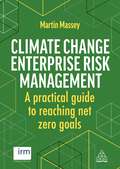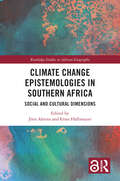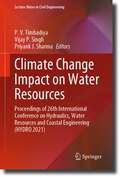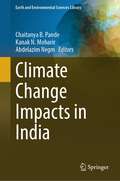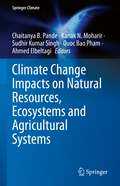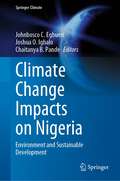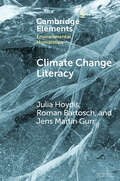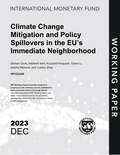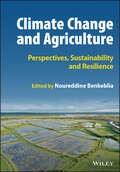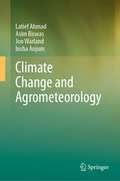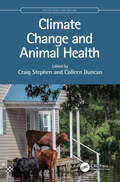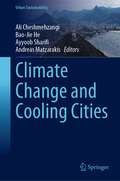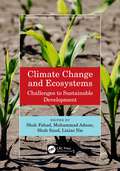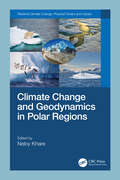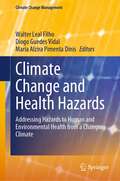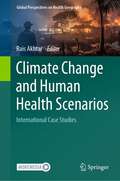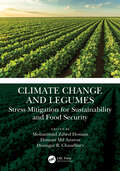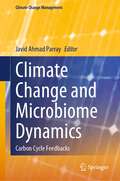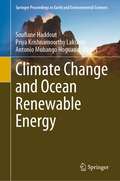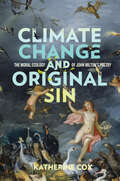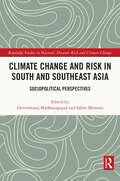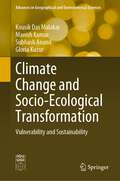- Table View
- List View
Climate Change Enterprise Risk Management: A Practical Guide to Reaching Net Zero Goals
by Martin MasseyDevelop and execute a resilient climate change enterprise risk strategy that can be tailored to any organization with this essential guide for risk professionals and business leaders. Climate Change Enterprise Risk Management equips readers with a practical roadmap for how organizations can integrate climate change into their enterprise risk strategy. It offers guidance on how to secure a robust framework that can identify and manage climate threats and opportunities for a business, how to increase the visibility of climate risk management activities at board level, and how and when to implement techniques such as thresholds, mitigation strategies, monitoring capabilities and risk appetite metrics. The book covers both existing best practice risk management tools and how they can be adapted for climate enterprise risk management as well as new interdisciplinary tools like stakeholder mapping. Climate Change Enterprise Risk Management is richly supported by global examples, interviews and case studies representing a wide range of companies and industries including the insurance, finance, infrastructure, oil and gas, legal and auditing sectors.This is a must-read for all risk professionals and business leaders involved in developing and executing enterprise risk management and strategy. It will also be valuable reading for students taking modules on enterprise risk management and climate change, sustainable business and risk management.
Climate Change Epistemologies in Southern Africa: Social and Cultural Dimensions (Routledge Studies in African Geography)
by Jörn Ahrens and Ernst HalbmayerThis book investigates the social and cultural dimensions of climate change in Southern Africa, focusing on how knowledge about climate change is conceived and conveyed. Despite contributing very little to the global production of emissions, the African continent looks set to be the hardest hit by climate change. Adopting a decolonial perspective, this book argues that knowledge and discourse about climate change has largely disregarded African epistemologies, leading to inequalities in knowledge systems. Only by considering regionally specific forms of conceptualizing, perceiving, and responding to climate change can these global problems be tackled. First exploring African epistemologies of climate change, the book then goes on to the social impacts of climate change, matters of climate justice, and finally institutional change and adaptation. Providing important insights into the social and cultural perception and communication of climate change in Africa, this book will be of interest to researchers from across the fields of African studies, sociology, anthropology, philosophy, political science, climate change, and geography.
Climate Change Impact on Water Resources: Proceedings of 26th International Conference on Hydraulics, Water Resources and Coastal Engineering (HYDRO 2021) (Lecture Notes in Civil Engineering #313)
by Vijay P. Singh P. V. Timbadiya Priyank J. SharmaThis book comprises the proceedings of the 26th International Conference on Hydraulics, Water Resources and Coastal Engineering (HYDRO 2021) focusing on broad spectrum of emerging opportunities and challenges on the impact of climate change on water resources. It covers a range of topics, including, but not limited to, climate change assessment and downscaling issues, climate change impact and adaptive measures, influence of climate variability on hydro-climatic variables, impact of climate change on water resources of Indian Rivers, etc. Presenting recent advances in the form of illustrations, tables, and text, the content offers readers insights for their own research. In addition, the book addresses fundamental concepts and studies on the impact of climate change on water resources, making it a valuable resource for both beginners and researchers wanting to further their understanding of hydraulics, water resources and coastal engineering.
Climate Change Impacts in India (Earth and Environmental Sciences Library)
by Abdelazim Negm Chaitanya B. Pande Kanak N. MoharirThis book focuses on the impact of climate change on India, addressing environmental problems and conducting an analysis of the climate change impact on mitigation processes. It examines crucial factors such as soil capability, soil erosion, soil salinity, and watershed planning, as well as the influence of climate change on water resources, including groundwater. The book explores the interconnections between climate change, soil erosion, natural resources, and agricultural practices, emphasizing their direct or indirect effects on water, vegetation, irrigation planning, and the environment.Furthermore, it delves into various aspects of soil erosion, soil compaction, soil nutrients, aquifers, and the impact of climate change on vegetation, crops, pests, moisture, and sustainable yield. These factors contribute to the development of climate change-related factors within the agricultural sector, ultimately fostering sustainable development and management practices for the future. The book also highlights the significance of parameters such as land use change analysis, rainfall, water resources, crop yield, sustainable agricultural development, pest management, and disease control in accurately assessing the impact of climate change. The insights gained from these analyses can inform future development and planning strategies. Therefore, this book serves as a valuable resource for researchers, scientists, NGOs, and academics interested in understanding the impact of climate change on natural resources and ecological systems.
Climate Change Impacts on Agriculture: Concepts, Issues and Policies for Developing Countries
by Muhammad Zaffar Hashmi Khalid Mahmood Shah Fahad Wajid Nasim Jatoi Muhammad Mubeen Shaukat AliThis book offers perspective on climate change impacts on developing nations from scholars within those nations, primarily focusing on agriculture. Throughout three parts containing a total of over twenty chapters from scholars in developing countries, it aims to offer guidelines for researchers, policymakers, and farmers themselves on how developing countries can achieve sustainable food security and continue development on a sustainable basis.Part I covers climate change concepts and issues for developing countries; Part II offers chapters dealing with social issues surrounding climate change and agriculture; Part III addresses practical policies that can be implemented to work toward achieving the goals described above. Agriculture is a key sector in developing countries in terms of economic growth and social well-being. Adapting and building resilience to climate change means increasing agricultural productivity and incomes and reducing greenhouse gases emissions. This volume represents an effort toward collecting knowledge on the technical, policy and investment measures to achieve sustainable agricultural growth in the sectors of grain, fruit, vegetable, fiber, feed, livestock, fisheries and forest under climate change in one place.
Climate Change Impacts on Natural Resources, Ecosystems and Agricultural Systems (Springer Climate)
by Sudhir Kumar Singh Chaitanya B. Pande Kanak N. Moharir Quoc Bao Pham Ahmed ElbeltagiThis book on the climate change, natural resources, landscape and agricultural ecosystems describes the contributing challenges related to natural resources, soil erosion, irrigation planning, water, landscape, sustainable crop yield agriculture and biomass estimation. Natural resources and agricultural ecosystems include factors from nearby regions where landscape and agriculture practices (direct or indirect) interface with the water, vegetation, irrigation planning and ecology. Changes in climatic situations impact all the natural resources, ecology, and landscape of agricultural systems, which affects productivity. This book summarizes the various aspects of soil erosion, soil compaction, soil nutrients, aquifer and water with respect to vegetation, crops, pest and sustainable yields and management for the future. It also focuses on the use of precision techniques, remote sensing, GIS technologies, IOT and climate related technology for the sustainability of ecology, natural resources and agricultural areas, along with the capacity and flexibility of natural resources and agricultural societies under climate change. This book presents both theoretical and applied aspects and will help as a guide for future research. The contents will appeal to researchers, scientists, and NGOs working in climate change, environmental sciences, agriculture engineering, remote sensing, natural resources management, remote sensing, GIS, hydrologist, soil sciences, agricultural microbiology, plant pathology and agronomy.
Climate Change Impacts on Natural Resources, Ecosystems and Agricultural Systems (Springer Climate)
by Sudhir Kumar Singh Chaitanya B. Pande Kanak N. Moharir Quoc Bao Pham Ahmed ElbeltagiThis book on the climate change, natural resources, landscape and agricultural ecosystems describes the contributing challenges related to natural resources, soil erosion, irrigation planning, water, landscape, sustainable crop yield agriculture and biomass estimation. Natural resources and agricultural ecosystems include factors from nearby regions where landscape and agriculture practices (direct or indirect) interface with the water, vegetation, irrigation planning and ecology. Changes in climatic situations impact all the natural resources, ecology, and landscape of agricultural systems, which affects productivity. This book summarizes the various aspects of soil erosion, soil compaction, soil nutrients, aquifer and water with respect to vegetation, crops, pest and sustainable yields and management for the future. It also focuses on the use of precision techniques, remote sensing, GIS technologies, IOT and climate related technology for the sustainability of ecology, natural resources and agricultural areas, along with the capacity and flexibility of natural resources and agricultural societies under climate change. This book presents both theoretical and applied aspects and will help as a guide for future research. The contents will appeal to researchers, scientists, and NGOs working in climate change, environmental sciences, agriculture engineering, remote sensing, natural resources management, remote sensing, GIS, hydrologist, soil sciences, agricultural microbiology, plant pathology and agronomy.
Climate Change Impacts on Nigeria: Environment and Sustainable Development (Springer Climate)
by Chaitanya B. Pande Johnbosco C. Egbueri Joshua O. IghaloThis book explores the impacts of climate change on Nigeria. How climate change impacts the productivity and future development of different sectors in Nigeria was covered in this book. Various themes of the Nigerian economy, environment, and climate change were considered. Worthy of note are the impacts of climate change on the Nigerian air quality, surface and groundwater resources, watershed and natural resources’ development and planning, soil- quality, fertility, salinization, nutrients and cropping patterns. Also, the impact of climate change on land use/land cover, urbanization and strategic planning, crops and sustainable crop yield; land degradation, soil erosion, landslides and landscapes, rainfall trend patterns, drought vulnerability; ecology, vegetation/forest, carbon and biomass management of Nigeria were investigated. Finally, the problems of climate change in semi-arid and arid regions (with special emphasis on Nigeria) and possible solutions for sustainable development under the changing climate were discussed in this book. Advanced technologies, such as remote sensing, GIS, multivariate analytical tools, and machine learning techniques, were utilized in the exploration and analysis of the themes of this book. Thus, this book is a very important product for point of view researchers, scientists, NGOs, and university communities on the Nigerian climate change. This book is a useful interdisciplinary tool, cutting across various disciplines such as earth sciences, hydrology, environmental sciences, soil science, engineering, remote sensing, natural resources management, and public health management, etc.
Climate Change Literacy (Elements in Environmental Humanities)
by Jens Martin Gurr Roman Bartosch Julia HoydisThis Element presents a necessary intervention within the rapidly expanding field of research in the environmental humanities on climate change and environmental literacy. In contrast to the dominant, science-centred literacy debates, which largely ignore the unique resources of the humanities, it asks: How does literary reading contribute to climate change communication? How does this contribution relate to recent demands for environmental and related literacies? Rather than reducing the function of literature to a more pleasurable form of information transfer or its affective dimension of evoking sympathy, climate change literacy thoroughly reassesses the cognitive, affective, and pedagogic potentials of literary writing. It does so by analysing a selection of popular climate novels and by demonstrating the role of fiction in fostering a more adequate understanding of, and response to, climate change. This title is also available as Open Access on Cambridge Core.
Climate Change Mitigation and Policy Spillovers in the EU’s Immediate Neighborhood (Imf Working Papers)
by ZhaoA report from the International Monetary Fund.
Climate Change Strategies: Handling the Challenges of Adapting to a Changing Climate (Climate Change Management)
by Walter Leal Filho Marina Kovaleva Fátima Alves Ismaila Rimi AbubakarThis book includes information, experiences, practical initiatives and projects around the subject matter and makes it available to a wide audience. It addresses the scientific, social, political and cultural aspects of climate change impacts and respective solutions in an integrated and coherent way.Climate change as a global phenomenon imposes new challenges for survival. Extreme weather events including heat waves, storms, droughts as well as rising sea levels, warming oceans and melting glaciers threaten people's livelihoods and communities, ecosystems and habitats. Furthermore, it affects the entire food chain and increases competition for natural resources fuelling socioeconomic tensions. The results of the latest IPCC report highlight the urgent need for combating climate change. The adaptation measures to be undertaken range across sectors, thematic fields and geographical locations.Based on this need, the book focuses on the high-quality, interdisciplinary contributions on the scientific, social, economic, political and cultural aspects of climate change challenges and solutions
Climate Change and Agriculture: Perspectives, Sustainability and Resilience
by Noureddine BenkebliaClimate Change and Agriculture Authoritative and comprehensive resource covering climate-smart agriculture with key insights into its implementation Climate Change and Agriculture provides a complete overview of the development of sustainable agroecosystems and cropping systems and details how to improve the resilience of cultivated crops and cropping systems to the adverse conditions of the climate, such as drought, increasing levels of carbon dioxide, global warming, and many other secondary effects such as soils fertility depletion, uncommon disease, and pests. Additionally, the text suggests different agricultural practices to face the severity of frequency of the natural events. Climate Change and Agriculture also delves into the different climate-resilient methods and climate-smarter agriculture (CSA) for food production by building healthier soils through different sustainable practices, redesigning diverse agroecosystems, and developing new crop varieties, livestock breeds, and farm practices. Insight into how modern technology has affected the field, and how it may affect the field in the future, is included. Other topics discussed in Climate Change and Agriculture include: Climate change and agriculture (state of the art, challenges, and perspectives), plus studies on crop yields and their extreme value analysis over India Symbiosis for food security and sustainability in changing climate and emerging issues related to conservation agriculture in Africa The role of periurban agriculture in sustainability and climate change, with additional information on nutrient management in agro-ecosystems Soil fertility management and biofertilization in changing climate and biochar mitigating abiotic stress-induced damages under changing climate For academics and students; seed, fertilizer, and chemical producers; farmers and farming communities; and policy makers, Climate Change and Agriculture contains invaluable insights into the subject that are helpful in understanding the current state of the field and preparing for potential future developments.
Climate Change and Agrometeorology
by Latief Ahmad Asim Biswas Jon Warland Insha AnjumThe monograph focuses on agricultural meteorology and climate change and its impacts on different crops. Comprising of chapters from experts, the book discusses and provides first-hand information to the long term shifts in weather patterns and temperature impacting soil, water and crops. Each chapter focuses in detail on the impact of plant- water – soil nexus and climate change on agriculture and food security. Covering the basic concepts about the temperature, pressure and humidity correlation with the increased demands of food, the book explores in detail the impact of adverse climatic conditions like drought, floods, increasing levels of carbon dioxide emissions and other simultaneous effects like soil fertility depletion on the cropping systems and overall crop productivity. The book touches the challenges of climate change, adaptive methods, mitigation strategies, with careful explanation of governance, plans and policies required to provide guidelines to stake holders so they can best prepare for the negative climate change impacts. While touching the agricultural challenges faced globally due to climate change, the book serves as a reference book for students, researchers and policy makers, involved in horticulture, agriculture and environmental sciences and climate change.
Climate Change and Animal Health (CRC One Health One Welfare)
by Colleen Duncan Craig StephenThis benchmark publication assembles information on the current and anticipated effects of climate change on animal health. It empowers educators, managers, practitioners, and researchers by providing evidence, experience, and opinions on what we need to do to prepare for, and cope with, the largest threat ever to have faced animals on this planet. With expert contributors from across the globe, the text equips the reader with information and means to develop sustainable adaptation or mitigation actions. After introducing animal health in a climate change context, chapters look at specific animal health impacts arising from climate change. The book concludes with suggestions on teachable and actionable ideas that could be used to mobilize concepts provided into education or advocacy. This book was written amid the COVID-19 pandemic and in the face of ever-increasing reports of on-the-ground, real-life climate impacts. Large scale wildfire and ocean heat waves killed unprecedented numbers of animals while droughts in some areas and floods in others displaced thousands of livestock and made food scarce for even more. Climate change is real, and it is here. How we respond will have profound implications for people, biodiversity, welfare, conservation, societies, economies and ecosystems. Today's veterinary educators are awakening to the need to adapt and train a new generation of animal health professions who can understand and plan for climate change, and this book is an essential resource.
Climate Change and Cooling Cities (Urban Sustainability)
by Ali Cheshmehzangi Ayyoob Sharifi Bao-Jie He Andreas MatzarakisThis edited book provides a solid foundation for future research on cooling cities, climate change impacts on cities and urban environments, and innovative mitigation and adaptation strategies. With ever-increasing climate change impacts on our living environments and continuous calamities and natural disasters around the world, we urge for new approaches, apt action, and adequate support to boost cooling strategies for the built environments. To achieve this goal, research, practice, and policy could do much more to provide us with new pathways to achieve sustainable development. This book is a comprehensive collection of theoretical perspectives and global case study examples focused on three core areas of (1) concepts, theories, and trends, (2) mitigation and adaptation strategies, and (3) policies. The book is of use to various stakeholders and more importantly to urban specialists, planners and designers, policymakers, academics, practitioners, and developers. We urge them to mitigate climate change before it gets too late. We are confident the book could provide readers with new ideas, strategies, and directions that could lighten up the path toward new actions, policies, and innovation.
Climate Change and Ecosystems: Challenges to Sustainable Development (Footprints of Climate Variability on Plant Diversity)
by Shah FahadThe global population is projected to increase by 3.3 billion from 6.7 billion in 2008 to 10 billion in 2100. As a result, soil degradation and desertification are growing due to the increasing demand for food, feed, fiber, and fuel on finite soil resources. The problem of global food insecurity may be further worsened by the threat of global warming. Climate change is showing its impacts in terms of increasing temperatures, variable rainfall, and an increase in climate-related extremes such as floods, droughts, cyclones, sea-level rise, salinity, and soil erosion. The agriculture sector is the most sensitive to climate change because the climate of a region/country determines the nature and characteristics of vegetation and crops. Increase in the mean seasonal temperature and decrease in effective precipitation can reduce the duration of many crops, may lead to outbreaks of pests and diseases, and hence reduce final yield ultimately affecting the food security of the country. Despite the positive impact of CO2 fertilization, the net productivity may decrease because of an increase in respiration rate, drought stress, and nutrient deficiency. For example, for every 75 ppm increase in CO2 concentration, rice yields will increase by 0.5 t/ha, but the yield will decrease by 0.6 t/ha for every 1°C increase in temperature. The global agricultural productivity is expected to decrease from 3% to 16% by 2080. The estimated decrease in agricultural productivity in the developing countries is 10%–25% in the 2080s, where average air temperature is already near or above crop tolerance levels. This book is intended to serve as a stimulating collection that will contribute to debate and reflection on the sustainable future of agriculture and food production in the face of global change.Features: This book brings together a multidimensional group of international scholars exploring the ethical dimensions of climate change and ecosystem. New strategies have been pointed out in this book for better sustainable development. This book has been designed to provide a good overview of major challenges facing policymakers, researchers, and ultimately humankind in dealing with climate change. This book summarizes the diverse features of vulnerability, adaptation, and amelioration of climate change in respect to plants, crops, soil, and microbes for the sustainability of the agricultural sector, and, ultimately, food security for the future. This book provides a state-of-the-art description of the physiological, biochemical, and molecular status of the understanding of abiotic stress in plants.
Climate Change and Geodynamics in Polar Regions (Maritime Climate Change Ser.)
by Neloy KhareClimate Change and Geodynamics in Polar Regions covers most of the scientific aspects of geoscientific investigation undertaken by Indian researchers in the polar regions: the Antarctic, Arctic, and Himalayan regions. A firm understanding of the cryosphere region's geological perspectives helps students and geoscientists evaluate important scientific queries in the field. This book will help readers understand how the cryosphere’s geoscientific evolution took place in the geological past, climate change throughout history, and how polar regions were affected by global warming. It also discusses how we might expect polar climate to change in the future. A firm understanding of the cryosphere region's geological perspectives helps students and geoscientists answer some of the most puzzling scientific queries and generate new ideas for future research in this field.
Climate Change and Health Hazards: Addressing Hazards to Human and Environmental Health from a Changing Climate (Climate Change Management)
by Walter Leal Filho Diogo Guedes Vidal Maria Alzira Pimenta DinisThis book contains a set of papers which explore the links among climate change, health, and hazards and demonstrate how they interact. It emphasizes the urgency of immediate and more ambitious action to address climate risks. According to the Intergovernmental Panel on Climate Change (IPCC), human-induced climate change is known to be causing dangerous and widespread disruptions in nature and is affecting the lives of billions of people around the world, despite efforts to reduce the risks. Climate change is also negatively influencing health and is mounting threat to our wellbeing and a healthy planet. The world is also facing significant climate hazards over the next two decades, with global warming expected to soon reach 1.5°C. Even temporarily exceeding this warming level will result in additional severe impacts, some of which may be irreversible. There is therefore a perceived need for publications which may foster a greater understanding of how climate change connects to human health and the role played by hazards in this context. It is against this background that this book is being prepared.
Climate Change and Human Health Scenarios: International Case Studies (Global Perspectives on Health Geography)
by Rais AkhtarThe objective of the present edited book is to encompass studies from both developed and developing countries of Asia, Africa Europe, and Americas, to understand and present a comparative scenario of the climate change and other environmental determinants of health and disease in geographically diversified countries. Environment and health perspective dates back to Hippocrates treatise written 400 B.C.E. In his book On Airs, Waters and Places, Hippocrates described diseases as associated with environmental conditions, “Whoever wishes to investigate medicine properly, should proceed thus: in the first place to consider the seasons of the year, and what effects each of them produces for they are not at all alike, but differ much from themselves in regard to their changes. Then the winds, the hot and the cold, especially such as are common to all countries, and then such as are peculiar to each locality. We must also consider the qualities of the waters, for as they differ from one another in taste and weight, so also do they differ much in their qualities. In the same manner, when one comes into a city to which he is a stranger, he ought to consider its situation, how it lies as to the winds and the rising of the sun; for its influence is not the same whether it lies to the north or the south, to the rising or to the setting sun”.There has been a greater emphasis in the last four decades on understanding environmental factors which affect human health, after United Nations established Intergovernmental Panel on Climate Change (IPCC) in 1988 aimed at to evaluate research on changing environmental condition, particularly climate change and its impacts on human wellbeing, including human health, as consequences of extreme heat waves conditions, sea level rise, forced migration, air pollution, droughts, and wildfires. From these studies, risk levels of vulnerable populations and regions can be assessed and level of resilience of healthcare infrastructure that may be used in environmental health policy and equity of these countries.
Climate Change and Legumes: Stress Mitigation for Sustainability and Food Security
by Doongar R. Chaudhary Hossain Anawar Mohammad Zabed HossainGlobal climate change has created unprecedented challenges for human civilization due to its widespread adverse consequences, including a reduction in crop yield and threatening food security across the globe. Among the crop plants, legumes have great potential for ameliorating global warming since they can reduce carbon emissions by lowering reliance on the application of chemical fertilizers, by increasing nitrification and carbon sequestration in soil, and by providing protein-rich diets to both humans and livestock. This book identifies the extent of climate-induced stresses on legume plants and focuses on achieving food security through sustainable agricultural practices.This book compiles recent research findings and reviews on climate-related problems, the potential of legumes in ameliorating the impacts of climate change, as well as better management of agricultural land and practices for achieving environmental sustainability and food security.This book will serve as guidelines for scientists, agricultural practitioners, and policymakers working to achieve food security and better management of climate-induced stresses in agricultural interventions. It will also be useful as a reference book for researchers and students of both graduate and postgraduate levels. Furthermore, this book will provide enhanced knowledge about the mechanisms of yield and stress tolerance of legumes as well as developing climate-smart crops and improving cropping systems for a sustainable environment and food security. Features of the book Reviews trends of global climate change and its consequences for food security across the continents Identifies the challenges and scopes of cultivating legumes in achieving food security in the context of global climate change Focuses on the improvements of legume production through conservation approaches in agricultural practices and modern techniques, including omics-based breeding, biotechnology, genetic engineering, and rhizobium technology Discusses the sustainable amelioration options for soils affected by climate-induced stresses Cites examples of applications of rhizobium technologies in reducing greenhouse gas emission Describes pathways associated with yield, resistance, and tolerance of legumes to climate-induced stresses
Climate Change and Microbiome Dynamics: Carbon Cycle Feedbacks (Climate Change Management)
by Javid Ahmad ParrayThe book provides an overview relevant to various biological mechanisms that regulate carbon exchanges between the major components and their response to climate change. Climate change has a significant impact on people's lives, energy demand, food security, etc. The soil microbial ecology is vital for assessing terrestrial and aquatic carbon cycles and climate feedback. However, the primary concern is the complexity of the soil microbial community and its severely affected functions due to the climate and other global changes. Global warming comprises an assessment of the dynamic interactions and feedback between microbes, plants, and their physical environment due to climate change. The book will address the need to use a multifactor experimental approach to understand how soil microorganisms and their activities adapt to climate change and the implications of carbon cycle feedback. The most pressing concern is a clearer understanding of the biological factors that regulate carbon exchanges between land, oceans, and the atmosphere and how these exchanges will respond to climate change via climate–ecosystem feedbacks, which could augment or quell regional and global climate change. Terrestrial ecosystems play an important role in climate feedback as they produce and absorb greenhouse gases like carbon dioxide, methane, and nitrous oxides. They also strongly contribute to storing enormous amounts of carbon in living vegetation and soils, rendering them a significant global carbon sink. If climate change projections are realistic, such a rapid increase in carbon loss from soil could exacerbate the soil carbon cycle feedback. The book will determine the role of microbial feedback in regulating soil-land-atmosphere carbon exchange under changing climatic conditions at the regional and global levels. The current book will also focus on recent research designed to use beneficial microbes such as plant growth-promoting microorganisms, fungi, endophytic microbes, and others to improve understanding of the interaction and their potential role in promoting advanced management for sustainable agricultural solutions. Understanding the influence on the native microbiome, such as the distribution of methanogens and methanotrophs, nutritional content, microbial biomass, and other factors, is becoming increasingly crucial to establishing climate-resilient agriculture.
Climate Change and Ocean Renewable Energy (Springer Proceedings in Earth and Environmental Sciences)
by Soufiane Haddout Priya Krishnamoorthy Lakshmi Antonio Mubango HoguaneRenewable-energy is energy that is collected from renewable resources that are naturally replenished on a human timescale. Renewable-energy includes sources such as sunlight, tides, waves, wind, rain, and geothermal heat. According to BP's-2018 Energy Outlook (EO), renewable energy will be the fastest growing source of energy, increasing fivefold by 2040 thus providing around 14% of global primary energy at this future point. On the other hand, climate change is bringing about rising temperatures, which have significant negative impacts on humans and the environment, and transitioning to renewable energy sources, such as biofuels, can help meet this challenge. Transitioning to renewable energy, and reducing reliance on fossil fuels, is one way to help slow down the effects of climate change. While renewables used to be a more expensive option, new clean energy technologies are lowering costs and helping to move economies away from fossil fuels. The 1st International Conference on Climate Change and Ocean Renewable Energy (CCORE 2022), is a virtual conference held from November 4-7, 2022, presenting experiences and ideas through research talks and presentations from diverse fields in climate change and ocean renewable energy. This event offers a platform in bringing together a forum for students, postdocs and established scientists to exchange their ideas and contribute to an integrative approach to climate change and ocean renewable energy.
Climate Change and Original Sin: The Moral Ecology of John Milton's Poetry (Under the Sign of Nature)
by Katherine CoxPrior to the Enlightenment era, how was the human-climate relationship conceived? Focusing on the most recent epoch in which belief in an animate environment still widely prevailed, Climate Change and Original Sin argues that an ecologically inflected moral system assumed that humanity bore responsibility for climate corruption and volatility.The environmental problem initiated by original sin is not only that humans alienated themselves from nature but also that satanic powers invaded the world and corrupted its elements—particularly the air. Milton shared with contemporaries the widespread view that storms and earthquakes represented the work of fearsome spiritual agents licensed to inflict misery on humans as penalty for sin. Katherine Cox’s work discerns in Paradise Lost an ecological fall distinct from, yet concurrent with, the human fall. In examining Milton’s evolving representations of the climate, this book also traces the gradual development of ideas about the atmosphere during the seventeenth century—a change in the intellectual climate driven by experimental activity and heralding an ecologically devastating shift in Western attitudes toward the air.
Climate Change and Risk in South and Southeast Asia: Sociopolitical Perspectives (Routledge Studies in Hazards, Disaster Risk and Climate Change)
by Salim Momtaz Devendraraj MadhanagopalThis book, focuses on South and Southeast Asia, upgrades our understanding of the influence of multiple sociopolitical and governance factors on climate change and risks. Moving beyond science and technology-oriented discussions on climate change, it argues that the real solutions to climate change problems lie in societies, governance systems, non-state actors, and the power and politics underpinning these systems. It presents a range of detailed conceptual, empirical, and policy-oriented insights from different nations of South and Southeast Asia, including India, Bangladesh, Sri Lanka, Indonesia, Vietnam, Maldives, and Bhutan. The chapters bring forth critical discussions of climate change, covering a diverse range of topics including livelihoods, gender, community perspectives, relocation, resilience, local politics, climate change communication, governance, and policy responses. By investigating climate change vulnerabilities and as well as offering feasible solutions to the states and other non-state actors in responding to climate change and risks, this book deepens our existing knowledge of the social and political dimensions of climate change. With interdisciplinary perspectives, this book will appeal to all students, researchers, and scholars of environmental studies, geography, disaster studies, sociology, policy studies, development studies, and political science. It provides valuable reading to practitioners, policymakers, and professionals working in related fields.
Climate Change and Socio-Ecological Transformation: Vulnerability and Sustainability (Advances in Geographical and Environmental Sciences)
by Manish Kumar Subhash Anand Kousik Das Malakar Gloria KuzurThis book focuses on various psycho-social and socio-physical aspects of climate change and includes a wide range of case studies. Included topics are notable climate-related social thinking; climate vulnerability; transformation in socio-ecological subsystems; bioclimatological, urban bioclimatological and socio-bioclimatic ideas; disasters; policy instruments; climate justice; human rights; and sustainability. The book distinguishes itself from similar works by including a wide variety of topics and assists policy management in the current and upcoming climate crisis era. This book also addresses the Sustainable Development Goals 13 (Take Urgent Action to Combat Climate Change and Its Impacts), highlighting resilience, recovery potential and adaptive capacity, climate change measures integrated into policies and planning, and knowledge and capacity to mitigate climate change. The ideas covered in this book evolved in response to the current climate crisis, ideas that the authors believe will aid in societal management and development in the present and future. The book is a useful source for planners, geographers, professionals, academics, government officials, laypeople, and others interested in climate change.
